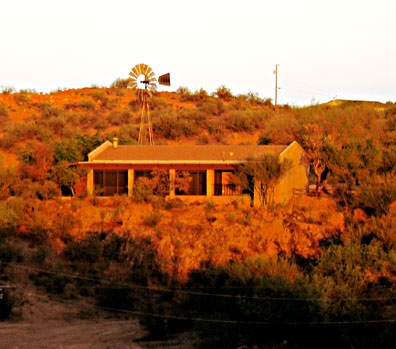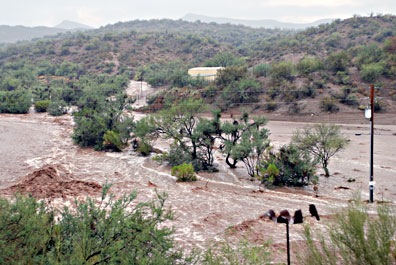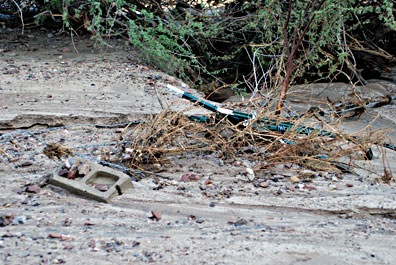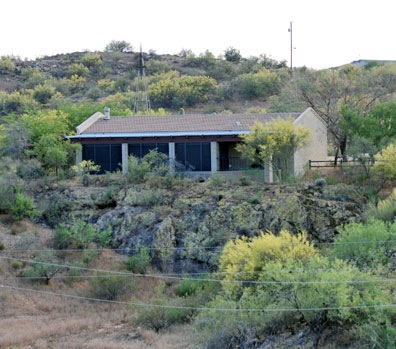Quickly makes you lose your mind.
Were you one of the three thousand or so cars that passed me today? I was driving the 1994 Ford F150 pickup with the bird cage stand in the bed, towing a 21-foot travel trailer from Wickenburg, AZ to West Wendover, NV.
The truck can pull the trailer, but barely. I’m lucky if I can get the speed up to 65 mph. Where the speed limit is 75 mph, everyone whizzes past me. Heck, they whiz past me just about everywhere, since I can’t keep the speed above 50 if I’m going uphill.
And there were lots of hills on this trip.
We — Alex the Bird and I — departed Wickenburg at 7:05 AM. The route, which was determined by Google Maps and adjusted to avoid Hoover Dam traffic, took us up U.S. 93 to I-40. We took the Interstate through Kingman, AZ and exited at Beale Street. Normally, we’d continue north on 93, but since I didn’t feel like dealing with a TSA search of the camper prior to crossing Hoover Dam, we hopped on State Route 68 to Bullhead City, crossed the Colorado River at Laughlin, and continued west on State Route 163. Then north on U.S. 95 to I-515 through Las Vegas. Then I-15 north to U.S. 93 north to S.R. 318 to U.S. 6 to U.S. 50 (briefly in Ely, NV) to U.S. 93 to U.S. 93A to West Wendover, NV.
Whew!
We were in the truck for 12 hours. I made one bathroom stop and two fuel stops, one of which included McDonalds. This was the first time I’d eaten at a McDonalds in at least three years. I hate myself for loving those fries.
I’ve never before been so aware of hills. The truck does okay on level ground and it even does pretty well going downhill. But get it on a slight incline going up and it’s an absolute dog. I mean, at times, I couldn’t even keep 50 MPH. When it dipped below 45 MPH, I had to turn the flashers on, like an underpowered, overloaded big rig climbing a hill.
Did I mention that quite a few of those passed me, too?
It’s funny, because everyone warned me to “take it slow” and “watch out for speed traps.” Hell, I’m more likely to get ticketed for driving too slow than for speeding.
Of course, there were exceptions. The ride down 68 to Bullhead City had a 6% downgrade for about 12 miles. I think that’s the only time I’ve ever been on a stretch of road with two runaway truck ramps. To save the breaks, I popped the truck into 2nd gear a few times to slow down. Worked like a charm. I had to repeat this exercise after a grueling climb up the other side of the Colorado River Valley on 163 when there was another section of road with a 6% grade.
I stopped for fuel at Searchlight, NV. Poor Alex seemed shell-shocked. I changed out his food and his water and closed him back in his box. (Alex travels in a lucite box with air holes, a perch, toys, and bowls for food and water. It’s really important to keep his box out of the sun when traveling.) I went into the camper to use the toilet and noticed that the fridge wasn’t running right. Later it seemed to be okay.
Then on to Las Vegas. I got a phone call from one of my cherry drying connections just as I neared the network of freeways there. When I hung up, I realized I was on I-515. I was supposed to be on I-15. But since the two highways merged north of the strip, I stuck with it. I had to pull over to make a phone call and I had to pull over again to check the bike rack after a passing car signaled me that it was loose. (It wasn’t that loose.)
Eventually, north of Vegas, I took the exit for 93 north. That started another trip through another featureless desert valley. Or maybe there were two of them. It’s easy to lose track in terrain like that. The mountains on either side were nice looking examples of uplifted sedimentary rock. But 93 miles of road with only 2 gas stations. And that’s where I nearly made a very big mistake.
The truck has two gas tanks. They each hold about 16 gallons of fuel. I usually stick with one tank until I get to E, then switch to the other. I’d switched to the second tank and had 3/4 tank left. So when I passed that second gas station, it never occurred to me to buy fuel.
I drove another 100 miles before I reached the next gas station. By that time, I’d completely drained the second tank — the engine was sputtering when I flicked the switch to change tanks. I was back on the first tank, seeing how far into the red I could get on its gauge when I reached the gas station. I would have been completely out of gas within five miles.
The pumps were so old that they couldn’t handle the math for fuel prices over a dollar. You know the kind of pumps. The digits aren’t created with LEDs or LCDs — they’re on a wheel and roll over as the numbers change. The owners of the place had taped the per gallon price ($4.28) written on a piece of cardboard over the place where the purchase total usually appears. I got out and spoke to the two women in the shack adjacent to the pumps. “I sure hope those pumps work,” I said. They assured me that they did.
I got two bars on my cell phone and used the opportunity to call Mike and check in. Good thing I did. An hour later, I had no cell signal at all. And I wouldn’t have one for more than two hours.
If you’ve never driven through the emptiness of Nevada, you probably have little idea of what it’s like. I’ve driven in every state of this country except Minnesota and there’s no state that has more nothing than Nevada. Sure, the rugged, rocky, barren mountains are pretty — for the first hour or so. The valleys between them are often nothing more than vast plains of nothingness. Think salt flats or dry lake beds or mile after mile of scrubby vegetation clinging to existence on scant rainfall and harsh winters.
I’d hoped to write something interesting about the drive, but there’s nothing memorable about it other than miles of straight, empty blacktop cutting through the desert. If I’d broken down, I’d have to hope one of the dozen or so cars who passed each hour would be kind enough to stop. At least I was dragging along a little house with me if I had to spend the night out there.
Things changed when I neared Ely. I’d climbed into high desert, over 6,000 feet. The truck seemed to be wheezing for breath in the thin air; I was lucky to get 40 miles per hour when we climbed through the pass just south of town. I decided to call it quits for the day. It was 5 PM and I was getting tired.
But Ely — no offense to the people who live there — didn’t have much to offer. Sure, there was an historic downtown that looked kind of interesting. But I needed to park an RV and I needed to spend the night in it with Alex the Bird. (How many hotels do you think take parrots?) There was a casino on the east side of town with a sign promising $15 RV sites. But the parking lot was dirt and the whole place looked sad and neglected. I kept driving.
An hour later, I reached a crossroads. I was supposed to turn left on route 93 to head north toward Wells. But Wells, which was 78 miles away, was a speck on the map on I-80 and I didn’t know what I’d find there. If I kept straight on 93A, I’d reached West Wendover in 59 miles. The map promised a bigger town. What I saw inmy mind was a Nevada gambling town on the border of Nevada and Utah, right on I-80. I imagined casinos with big parking lots for trucks and RVs. It wouldn’t take me too far off course. So I continued on 93A.
 I rolled into West Wendover around 7 PM. It was exactly as I’d imagined it. Bigger, in fact. I homed in on the casino with the brightest lights and biggest parking lot. I pulled into a spot at the far end of the parking lot and used Google Maps in my Treo to look up the casino’s phone number. Minutes later, I had the security department’s permission to park there rather than in the truck parking lot across the street. This shot was taken with my Treo a while later, after dinner in the casino’s steakhouse.
I rolled into West Wendover around 7 PM. It was exactly as I’d imagined it. Bigger, in fact. I homed in on the casino with the brightest lights and biggest parking lot. I pulled into a spot at the far end of the parking lot and used Google Maps in my Treo to look up the casino’s phone number. Minutes later, I had the security department’s permission to park there rather than in the truck parking lot across the street. This shot was taken with my Treo a while later, after dinner in the casino’s steakhouse.
I’d been on the road for 12 hours with six short stops. I’d covered more than 650 miles. I was halfway to Quincy.

 This has evidently been circulating around the Web. I received it with a note this morning from my friend, Tom, and thought I’d share it here:
This has evidently been circulating around the Web. I received it with a note this morning from my friend, Tom, and thought I’d share it here: The house was one of the very first built in our area. It’s a one-story structure with just two bedrooms and two baths, perched on a rocky, lichen-covered outcropping. At the base of the rocks was a densely vegetated flood zone, filled with local trees and bushes slightly higher than the level of Cemetery Wash, which also flows through our property. Up at house level were irrigated trees so mature that they blended in perfectly with the home. The house seemed to be part of the landscape. And in the morning, when the first light of day hit it from the east, it glowed red, as shown in this July 2007 photo.
The house was one of the very first built in our area. It’s a one-story structure with just two bedrooms and two baths, perched on a rocky, lichen-covered outcropping. At the base of the rocks was a densely vegetated flood zone, filled with local trees and bushes slightly higher than the level of Cemetery Wash, which also flows through our property. Up at house level were irrigated trees so mature that they blended in perfectly with the home. The house seemed to be part of the landscape. And in the morning, when the first light of day hit it from the east, it glowed red, as shown in this July 2007 photo. Monsoon season came and the first heavy rain brought a massive flash flood. The sand berms were no match for the power of flowing water. The water coming down the wash was no longer held back by the dense vegetation that had grown below the house. The wash changed its course, flooding the undeveloped “pasture” and cutting across the bottom of our access road. The rushing water completely flooded the sandy area in our part of the flood plain and, for the first time ever, our entire fence was washed away.
Monsoon season came and the first heavy rain brought a massive flash flood. The sand berms were no match for the power of flowing water. The water coming down the wash was no longer held back by the dense vegetation that had grown below the house. The wash changed its course, flooding the undeveloped “pasture” and cutting across the bottom of our access road. The rushing water completely flooded the sandy area in our part of the flood plain and, for the first time ever, our entire fence was washed away. When the water subsided, parts of our neighbor’s new fence were tangled across the access road to our neighbor’s house. Cinderblocks from their corral area littered our lower horse corral. Their “pasture” was filled with sand. Lucky they hadn’t set up the irrigation yet; it would have been destroyed.
When the water subsided, parts of our neighbor’s new fence were tangled across the access road to our neighbor’s house. Cinderblocks from their corral area littered our lower horse corral. Their “pasture” was filled with sand. Lucky they hadn’t set up the irrigation yet; it would have been destroyed. While I was out one day, workers took the head off the windmill and left it on the ground, at the base of one of the dead trees.
While I was out one day, workers took the head off the windmill and left it on the ground, at the base of one of the dead trees.